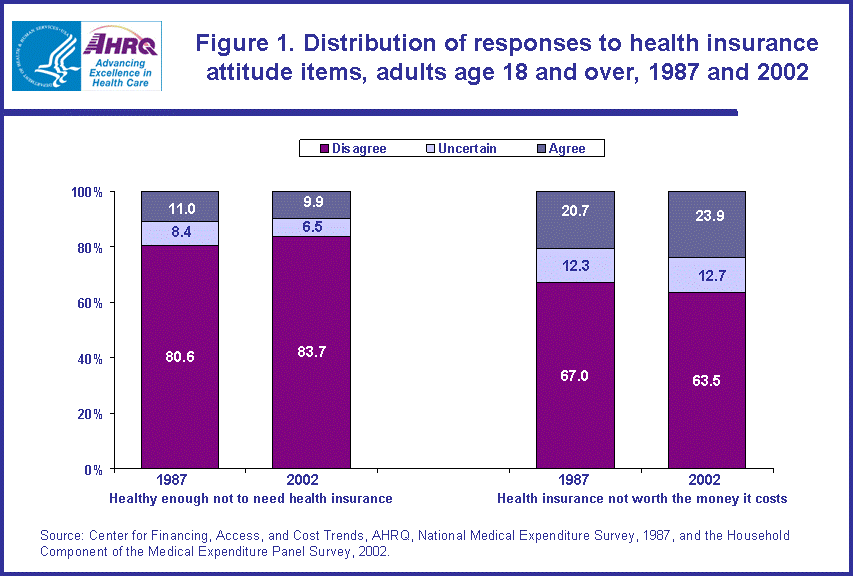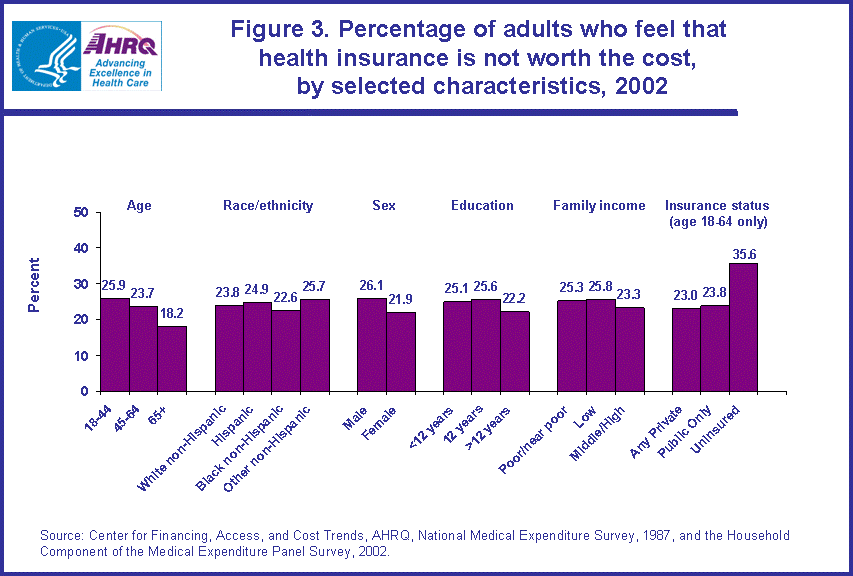
|
|
Font Size:
|
||||
|
|
|
|
||||
STATISTICAL BRIEF #87:
Attitudes toward Health Insurance among Adults Age 18 and Over
Highlights
- The percentage of adults age 18 and over who agreed with the statement "I'm healthy enough that I really don't need health insurance" was slightly lower in 2002 than 1987, while the percentage who agreed with the statement "Health insurance is not worth the money it costs" was slightly higher.
- In 2002, adults age 18-44 were more likely than persons age 65 and over to feel that they did not need health insurance because they were healthy and that health insurance was not worth the cost.
- Hispanics were more likely than non-Hispanic whites or non-Hispanic blacks to feel they were healthy and did not need health insurance.
- Men were more likely than women to feel that they did not need health insurance because they were healthy and also that health insurance was not worth the cost.
Introduction
Health insurance is viewed by policymakers and others concerned with the cost and quality of medical care as important for access to care and protection against the risk of costly and unforeseen medical events. Attitudes among consumers toward the need for and cost of health insurance may impact the extent to which the population is covered.
The 1987 National Medical Expenditure Survey (NMES) and the 2002 Medical Expenditure Panel Survey (MEPS) each contained questions that asked adults age 18 and over whether they strongly agreed, agreed, were uncertain, disagreed, or strongly disagreed with each of the following statements: "I'm healthy enough that I really don't need health insurance" and "Health insurance is not worth the money it costs."
This Statistical Brief examines differences in the extent to which persons agreed with these statements in 2002 versus 1987, as well as the variation in agreement with these attitudes in 2002 by selected demographic and socioeconomic characteristics (age, race/ethnicity, sex, education, family income, and insurance status for adults under 65). Strongly agreed and agreed responses were combined into an "agreed" category while strongly disagreed and disagreed responses were combined into a "disagreed" category. All differences between estimates discussed in the text are statistically significant at the 0.05 level or better.
Findings
Comparison of 1987 with 2002
There were small differences between 1987 and 2002 in the distribution of responses to the attitudes toward health insurance items. The percentage who agreed with the statement "I'm healthy enough that I really don't need health insurance" declined from 11.0 percent to 9.9 percent, while the percentage who agreed with the statement "health insurance is not worth the money it costs" increased from 20.7 percent to 23.9 percent (figure 1).
Variations among subgroups in 2002
Age. In 2002, adults age 18-44 were more likely than persons age 65 and over to feel that they did not need insurance because they were healthy (13.2 versus 5.8 percent) (figure 2) and to feel that health insurance was not worth the cost (25.9 versus 18.2 percent) (figure 3). Among persons age 45-64, the proportion who felt they did not need health insurance (6.8 percent) was closer to that for older persons (figure 2), while the proportion who felt health insurance was not worth the cost (23.7 percent) was closer to that for younger adults (figure 3).
Race/ethnicity. Hispanics were more likely (15.5 percent) than non-Hispanic whites or non-Hispanic blacks (about 9 percent each) to feel they were healthy and did not need health insurance (figure 2). However, there were no significant differences across race/ethnicity categories in the percentage of persons who felt that health insurance was not worth the cost--these percentages ranged from 22.6 percent to 25.7 percent (figure 3).
Sex. In 2002, males were more likely than females to feel that they did not need health insurance because they were healthy (12.5 versus 7.5 percent) (figure 2) and to feel that health insurance was not worth the cost (26.1 versus 21.9 percent) (figure 3).
Education. Adults with fewer than 12 years of education were more likely than persons with 12 or more years of education to feel they were healthy and did not need health insurance (12.2 percent versus about 9-10 percent) (figure 2). Further, adults with more than 12 years of education were slightly less likely to agree that "health insurance is not worth the cost" than persons with lower educational attainment (22.2 percent versus about 25-26 percent) (figure 3).
Family income. Adults in the poor/near poor income category were more likely to feel they were healthy and did not need health insurance than persons in the middle/high income category (12.2 versus 9.3 percent) (figure 2), but the percentage of persons who felt that health insurance was not worth the cost was not statistically different among these groups (25.3 versus 23.3 percent) (figure 3).
Insurance status (persons age 18-64 only). In 2002, the uninsured population 18-64 years old were more than twice as likely to feel they were healthy and did not need health insurance (18.9 percent versus about 9 percent for persons with private or public health insurance) (figure 2). In addition, about one-third of adults without health insurance felt that it was not worth the cost compared with approximately one-quarter of persons with private or public health insurance (figure 3). Among adults age 18-64 with health insurance, the percentages who agreed with the attitudinal statements toward health insurance were not significantly different for those with private versus public coverage (figures 2 and 3).
Data Source
The estimates in this Statistical Brief are based upon data from the 1987 NMES and the MEPS 2002 Full Year Consolidated Data file (HC-070).
Definitions
Racial and ethnic classifications
Classification by race and ethnicity is based on information reported for each family member. Respondents were asked if each family member's race was best described as American Indian, Alaska Native, Asian or Pacific Islander, black, white, or other. They also were asked if each family member's main national origin or ancestry was Puerto Rican; Cuban; Mexican, Mexicano, Mexican American, or Chicano; other Latin American; or other Spanish. All persons whose main national origin or ancestry was reported in one of these Hispanic groups, regardless of racial background, were classified as Hispanic. Since the Hispanic grouping can include black Hispanic, white Hispanic, Asian and Pacific Islanders Hispanic, and other Hispanic, the race categories of black, white, Asian and Pacific Islanders, and other do not include Hispanic. Beginning in 2002, MEPS respondents were allowed to report multiple races, and these persons were included in the other non-Hispanic category. As a result, there was a slight increase in the percentage of persons classified in this category in 2002 compared with prior years.
Health insurance status
- Private coverage: Private health insurance coverage was defined as nonpublic insurance that provided coverage for hospital and physician care (including TRICARE and Medigap coverage).
- Public only coverage: People were considered to have only public health insurance coverage if they were not covered by private insurance, and they were covered by Medicare, Medicaid, or other public hospital and physician coverage.
- Uninsured: People who did not have insurance coverage at any time during the survey year were classified as uninsured. People who were covered only by noncomprehensive State-specific programs (e.g., Maryland Kidney Disease Program) or private single service plans (e.g., coverage for dental or vision care only, coverage for accidents or specific diseases) were considered to be uninsured.
Each sample person was classified according to the total yearly income of his or her family. Within a household, all individuals related by blood, marriage, or adoption were considered to be a family. Personal income from all family members was summed to create family income. Based on the ratio of family income to the Federal poverty thresholds, which control for family size and age of the head of family, categories are defined as follows:
- Poor/near poor: Persons in families with income less than or equal 125 percent of the poverty line, including those who reported negative income
- Low income: Persons in families with income over 125 percent through 200 percent of the poverty line
- Middle/high income: Persons in families with income over 200 percent of the poverty line
About MEPS and NMES
The Medical Expenditure Panel Survey (MEPS) is the third in a series of nationally representative surveys of medical care use and expenditures. MEPS is cosponsored by the Agency for Healthcare Research and Quality and the National Center for Health Statistics. MEPS collects nationally representative data on health care use, expenditures, sources of payment, and insurance coverage for the U.S. civilian noninstitutionalized population. The first survey, the National Medical Care Expenditure Survey (NMCES) was conducted in 1977; and the second survey, the National Medical Expenditure Survey (NMES), was carried out in 1987.
NMES and MEPS data are released to the public in public use data files. NMES data files are available from the AHRQ Publications Clearinghouse (E-mail: ahrqpubs@ahrq.gov). MEPS data files are available on the MEPS Web site.
For more information about MEPS, call the MEPS information coordinator at AHRQ (301-427-1656) or visit the MEPS Web site at http://www.meps.ahrq.gov/.
References
For a detailed description of the MEPS Household Component survey design, sample design, and methods used to minimize sources of nonsampling error, see the following publications:Cohen, J. Design and Methods of the Medical Expenditure Panel Survey Household Component. MEPS Methodology Report No. 1. AHCPR Pub. No. 97-0026. Rockville, Md.: Agency for Health Care Policy and Research, 1997.
Cohen, S. Sample Design of the 1996 Medical Expenditure Panel Survey Household Component. MEPS Methodology Report No. 2. AHCPR Pub. No. 97-0027. Rockville, Md.: Agency for Health Care Policy and Research, 1997.
Cohen, S. Design Strategies and Innovations in the Medical Expenditure Panel Survey. Medical Care, July 2003: 41(7) Supplement: III-5-III-12.
For more information on the NMES survey design, see the following publications:
Cohen, S., DiGaetano, R., and Waksberg, J. Sample design of the 1987 Household Survey. AHCPR Pub. No. 91-0037. National Medical Expenditure Survey Methods 3. Agency for Healthcare Policy and Research. Rockville, Md.: U.S. Department of Health and Human Services, Public Health Service, 1991.
Edwards, W. and Berlin, M. Questionnaires and data collection methods for the household survey and the survey of American Indians and Alaskan Natives. DHHS Pub. No. (PHS) 89-3450. National Medical Expenditure Survey Methods 2. National Center for Health Services Research and Health Care Technology Assessment. Rockville, Md.: U.S. Department of Health and Human Services, Public Health Service, 1989.
Suggested Citation
Machlin, S. and Carper, K. Attitudes toward Health Insurance among Adults Age 18 and Over, 1987 and 2002. Statistical Brief #87. July 2005. Agency for Healthcare Research and Quality, Rockville, Md. http://meps.ahrq.gov/mepsweb/data_files/publications/st87/stat87.shtml
 |
||||||||||||||||||||||||||||||||||||||||||||||||||||||||||||||||||||||||||||||||||||||||||||||||
|
||||||||||||||||||||||||||||||||||||||||||||||||||||||||||||||||||||||||||||||||||||||||||||||||
|
|
||||||||||||||||||||||||||||||||||||||||||||||||||||||||||||||||||||||||||||||||||||||||||||||||
 |
||||||||||||||||||||||||||||||||||||||||||||||||||||||||||||||||||||||||||||||||||||||||||||||||
|
||||||||||||||||||||||||||||||||||||||||||||||||||||||||||||||||||||||||||||||||||||||||||||||||
|
|
||||||||||||||||||||||||||||||||||||||||||||||||||||||||||||||||||||||||||||||||||||||||||||||||
 |
||||||||||||||||||||||||||||||||||||||||||||||||||||||||||||||||||||||||||||||||||||||||||||||||
|
||||||||||||||||||||||||||||||||||||||||||||||||||||||||||||||||||||||||||||||||||||||||||||||||
|
|
||||||||||||||||||||||||||||||||||||||||||||||||||||||||||||||||||||||||||||||||||||||||||||||||


